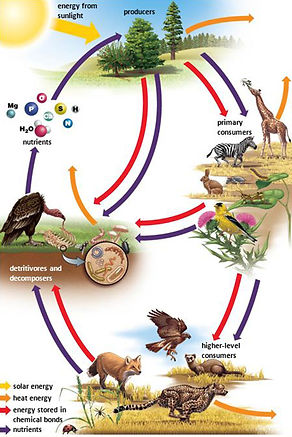
An ecosystem represents the level of biological organization between the community and biome levels. It is defined as a system formed by the interaction of a community of organisms with their environment.
On the largest scale, a plant is part of the global ecosystem. This level is mainly driven by solar radiation, precipitation cycles and, on longer timescales, geological activity. It is ultimately where all of the plant's energy, water and nutrients come from. After this, all other ecosystems are more or less involved in the management of these primary resources.


On a more local level, ecosystems
are mostly concerned with managing
The flow and recirculation of limited resources. A healthy ecosystem is the ultimate recycler and can keep a single phosphorus atom cycling continuously for thousands of years. However, to maintain a healthy ecosystem, large numbers of diverse organisms are required to balance the complex systems that make it work, and the greater the diversity, the more productive it becomes.

Problems arise when an ecosystem is out of balance. Ecological communities are adapted to specific environments. If the envionmental conditions swing too far from the optimal conditions, the interactions between the environment and the community begin to change.
This change can lead to a variety of other consequences that all act to collapse the ecosystem under threat. Once the environment starts to become unfavourable for existing organisms, other organisms better adapted to the new conditions will begin to invade and compete with the existing organisms. Weakened by competition and struggling to maintain homoeostasis, these individuals now also become open to opportunistic attack by pathogens or predators. If conditions do not improve, this will ultimately lead to the loss of keystone species and the eventual disappearance of the original ecosystem.
However, the opposite is also true.
As an environment moves closer to the ideal for a particular community, the more robust and healthy that community becomes; This is especially true as diversity grows.
Understanding this is the key!
By managing the environment so that it favours the desired ecosystem, we can improve the health and vibrancy of the individual members of that ecosystem!
Click to expand
Click to expand
Click to expand